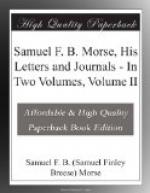It is rather curious to note that this is the first mention of a railroad made by Morse in his notes or letters, although he was evidently aware of the experiments which were being made at that time both in Europe and America, and these must have been of great interest to him. It is also well to bear in mind that the great development of transportation by rail could not occur until the invention of the telegraph had made it possible to send signals ahead, and, in other ways, to control the movement of traffic. At the present day the railroad at Carrara, which Morse saw in his visions of the future, has been built, but the ox teams are also still used, and linger as a reminder of more primitive days.
Continuing their journey, the travellers spent the night at Lucca, and in the morning explored the town, which they found most interesting as well as neat and clean. Leaving Lucca, “with much reluctance,” on the 18th, the journal continues:—
“At half-past five, at sunset, Pisa with its leaning tower (the duomo of the cathedral and that of the baptistery being the principal objects in the view), was seen across the plain before us. Towards the west was a long line of horizon, unbroken, except here and there by a low-roofed tower or the little pyramidal spire of a village church. To the southeast the plain stretched away to the base of distant blue mountains, and to the east and the north the rude peaks through which we had travelled, their cold tops tinged with a warmer glow, glittered beyond the deep brown slopes, which were more advanced and confining the plain to narrower limits.”
They found the Hotel Royal de l’Hussar an excellent inn, and, the next day being Sunday, they attended an English service and heard an excellent sermon by the Reverend Mr. Ford, an Englishman.
“In the evening we walked to the famous leaning tower, the cathedral, the baptistery, and Campo Santo, which are clustered together in the northern part of the city. In going there we went some distance along the quay, which was filled with carriages and pedestrians, among whom were many masques and fancy dresses of the most grotesque kind. It is the season of Carnival, and all these fooleries are permitted at this time. We merely glanced at the exterior of the celebrated buildings, leaving till to-morrow a more thorough examination.”
“Monday, February 16. We rose early and went again to the leaning tower and its associated buildings. The tower, which is the campanile of the cathedral and is about one hundred and ninety feet high, leans from its perpendicular thirteen feet. We ascended to the top by a winding staircase. One ascending feels the inclination every step he takes, and, when he reaches the top and perceives that that which should be horizontal is an inclined plane, the sensation is truly startling. It is difficult to persuade one’s self that the tower is not actually falling, and I could not but imagine at intervals




